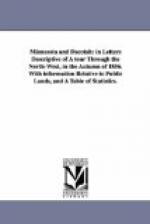The relative importance of the lumber business would hardly be estimated by a stranger. It has been carried on for at least six years; and considerable has found its way as far down as St. Louis. It will be asked, I imagine, if all this timber land, especially the pine, has been sold by the government; and if not, how it happens that men cut it down and sell it? I will answer this. The great region of pineries has not yet been surveyed, much less sold by the government. But notwithstanding this, men have cut it in large quantities, sold it into a greedy market, and made money, if not fortunes in the business. As a sort of colorable excuse for cutting timber, those employed in the business often make a preemption claim on land covered with it, and many people suppose they have the right to cut as much as they please after the incipient steps towards preemption. But this is not so. All that a claimant can do in this respect is to cut wood enough for his fuel, and timber enough for his own building purposes, until he receives a patent from the government. Of course it is altogether reasonable and proper that men should be precluded from doing so until their title in the soil is complete. Because, until a preemption claim is perfect, or, until the land has been acquired by some legal title, it is not certain that the claimant will ultimately secure it or pay any money to the government. But does not the government do anything to prevent these trespasses? Yes, but all its attempts are baffled.
For example, last spring a large quantity of splendid lumber was seized by the United States marshal and sold at public auction. It was bid off by the lumbermen themselves, who had formed a combination to prevent its falling into the hands of other purchasers. This combination had no resistance as I am aware of in the public opinion of the territory, and the timber was sold to those who had it cut at a price so far below its value that it didn’t pay the expense of the legal proceedings on the part of the government. This is accounted for in the fact of the exhaustless quantity of pine timber towards the north; in the demand for it when sawed; and in the disposition to protect enterprising men, though technically trespassers, who penetrate into the forest in the winter at great expense, and whose standing and credit are some guaranty of their ultimate responsibility to the government, should they not perfect their titles. The business of getting out the timber is carried on in the winter, and affords employment for a large number of athletic young men. The price of timber, I ascertained of Mr. P. D. Pratt, a dealer at St. Paul, is, for the best, $30 per M.; for common, $20.




